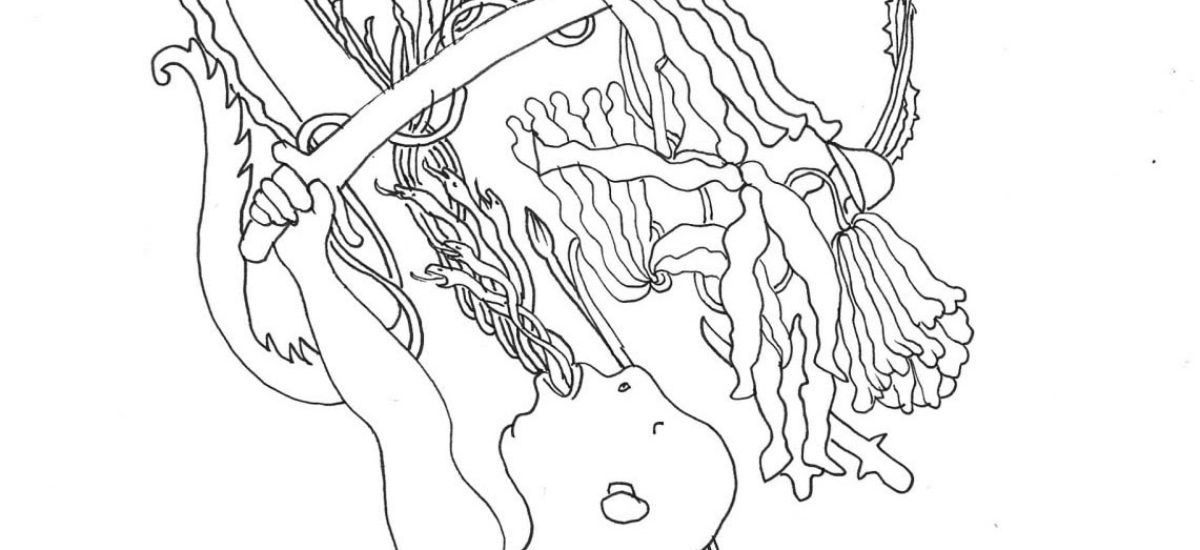Photo courtesy of Saskia Fernando Gallery
Since 1997, barring 2005, artist, sculptor, teacher and activist Professor Chandraguptha Thenuwara has been commemorating the horrific events of July 1983 in a series of exhibitions designed to make sure that people do not forget the tragic and long lasting impacts the violence has had on the country.
An illustration from his newest collection portrays a Buddhist monk brandishing a sword while snakes, dead lotuses and barbed wire spew from his mouth, depicting the violence that flows from hate speech. “I am showing that some people can make hate speech and others cannot; the sangha can do whatever it wants,” Professor Thenuwara said.
This year, he is having three memorial exhibitions marking 40 years since the events of the anti-Tamil pogrom.Delusion at Saskia Fernando Gallery will present his annual exhibition of new works in response to the sociopolitical climate in Sri Lanka. The exhibition will continue his inquiry into issues of militarism, religious extremism, conspiracy theories, Sinhala chauvinism, narrow-minded nationalism, anti-western agitation and socialism.
The complete sculptural installation, Covert, will be displayed, a part of which was exhibited at the 2022 Venice Biennale, at the Lionel Wendt Art Gallery. Through an infinite vortex of interlocking motifs – lotuses, soldiers, stupas and barrels – constructed out of wire which link and fuse, layer upon layer, like the meanings of the motifs themselves, the viewer is invited to reflect on the social and political history of the island.
Professor Thenuwara will also show an exhibition of artworks by six artists curated by him at the JDA Perera Gallery. Fragile: to commemorate the un-commemorated things is an attempt to understand the impact of Sri Lanka’s tumultuous history of violence and injustice and the issues that persist.
Professor Thenuwara spoke to Groundviews about the three exhibitions, the importance of remembering and the hypocrisy of governments.
Why is your new exhibition titled Delusions?
We are delusional as a society. There is so much disorder and fake evidence; there is no reality. We are misusing the International Covenant on Civil and Political Rights. Some people can do hate speech while others cannot. There are elements of parody, a play on words, in my work. The coalition between saffron and khaki is depicted. Now that talk of the 13th amendment is coming up, they are expressing their unwillingness to give a solution. All the old stories and conspiracy theories are being revisited, along with Sinhala Buddhist chauvinism. While there is no war going on and there is a so called peace, many issues remain unresolved. I am also revisiting barrelism in different ways by adding a new yellow pole. I am provoking the mind with colours, shapes and words. I use the letters MASS because we have mass media, massacres and mass graves. There is a sculpture of a dagoba because we think that by climbing to the top of a mountain and building a dagoba, everything will be ok.
What impact have you made with these many years of marking Black July?
Some people don’t know about the effects of July 83 while others forget about it. Remembering is important. While we are concentrating on economic issues, it is necessary to remember this. When responding to the current situation, people need to know about democracy, militarization, the political situation and the environment. Art can make these issues more clear. People are forgetting that society is very fragile and at any moment can erupt, therefore vigilance very important. We need to be critical beings instead of following orders and venerating politicians who are power hungry and looking for short term gains. I want people to make their own decisions rather than hiring others’ voices and to use their own minds and brains. They can enjoy my art and criticise it.
What are the other two exhibitions about?
Since this is an important year marking 40 years of Black July, I wanted young artists who do not have much exposure to art scene to be involved There are six artists; most are students and born after 1983 except for one. The theme is related to uncommemorated things. They show what is happening in their world and represent what they feel visually. The artist from Kilinochchi depicts bandaged eyes while the one from Kandy was affected by the Digana riots. The third exhibition, Covert, is the one that was shown at the Venice Biennale and has not been seen here.

